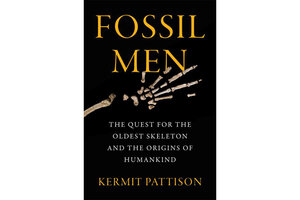‘Fossil Men’ explores breakthrough science – and human nature
A new book tracks the discovery of a ground-shaking addition to the fossil record, and shows how science ultimately comes down to the human element.

“Fossil Men: The Quest for the Oldest Skeleton and the Origins of Humankind” by Kermit Pattison, William Morrow, 534 pp.
HarperCollins Publishers
In the Afar Triangle region of Ethiopia – a formidable landscape known for prehistoric fossils, dangerous wildlife, and heavily armed insurgents – a team of scientists crawled slowly over the ground, looking for clues.
It was the early 1990s, and the group of researchers was led by Tim White, a brash and brilliant scientist from the University of California, Berkeley. As a paleoanthropologist, White focused on human fossil records. He had worked with – and then parted ways with – the famous Leakey family, the celebrities of the fossil hunting world; he had been part of the team that reconstructed and analyzed the 3.2 million-year-old partial Australopithecus afarensis skeleton known as Lucy, who for years was considered humankind’s oldest ancestor. And now he was on the trail of something even more groundbreaking.
His team had discovered a tooth, and then another, of a creature older than Lucy. Soon they found an arm bone, and parts of a leg, a foot, and a skull. Their work was painstakingly slow and exacting; they took weeks to reveal tiny specimens likely to crumble once in contact with air.
Eventually, they would recover more than 125 pieces of a skeleton – a 4.4-million-year-old female the team would call Ardi, short for Ardipithecus ramidus.
But that was just the beginning.
The paleontologists would take 15 years “to agonizingly reconstruct the skeleton and make sense of it,” writes Kermit Pattison in his new book, “Fossil Men: The Quest for the Oldest Skeleton and the Origins of Humankind.” They would enlist dozens of other scientists to study more fossils of extinct animals to reconstruct Ardi’s environment and build a geological timeline to frame her existence. And they would defend against attacks from other scientists and researchers. Ardi, they quickly recognized, was a threat to much of what the scientific world thought it knew about the way humans evolved.
“Together,” Pattison writes, “they would reveal new truths, send old notions to their graves, ignite hatreds, and cleave the scientific community.”
In “Fossil Men,” Pattison weaves the multiple intrigues of science, politics, and personalities into a masterly structured tale. It’s no easy task to write compellingly of the sort of minute details that absorb those who study, say, the same tiny foot bone for years on end.
Yet Pattison’s reporting and prose bring the readers into the excitement of scenes that turn on these details, such as when White and his colleagues realize that all human species, new and old, seem to have a facet in their cuboid foot bone.
This bit of anatomical trivia, in the context of their work, opens up new possibilities of how humans evolved. Perhaps humans did not evolve from apes, White’s team begins to reason. Perhaps apes actually evolved from human ancestors; or perhaps they were separate lines from a creature further removed. Through Pattison’s skillful rendering, readers get a sense of being in on the investigation and finally recognizing the clues in plain sight that begin to solve the mystery.
And this mystery is sprawling. In the quest to understand Ardi, scientists explore – and argue about – myriad theories that frame human evolution, from the idea that our ancestors evolved in savanna grasslands to the different possible reasons for why our predecessors started walking on two legs. “Fossil Men” shows the intricate science underlying these debates, from interpretations of carbon dating to genetic research.
By the end, the book leaves readers with a new sense of wonder at the origins of humankind. It certainly disrupts the outdated, simplistic view of humans evolving from apes, turning those diagrams of gorillas to knuckle-walkers to upright homo sapiens into vintage imagery from a less scientifically sophisticated past.
But it also does something more. In his recounting of the characters and science involved in Ardi’s discovery and the controversies that followed it, Pattison reveals the imperfect, all-too-human nature of science itself.
“Science is not just a quest for new facts; it also is a contest between rival models for interpreting nature,” he writes.
Humans are regularly blinded by what we think we know. We try to fit science into stories. We want to describe the past by comparing it to the present – even when that past is millions upon millions of years ago. We “hunger for more than just pure description – we search for meaning and emotionally satisfying endings, and that’s when we run astray, because our reach for narrative often exceeds our grasp of facts,” he writes. Nature “usually turns out to be more complex than what we imagine.”

